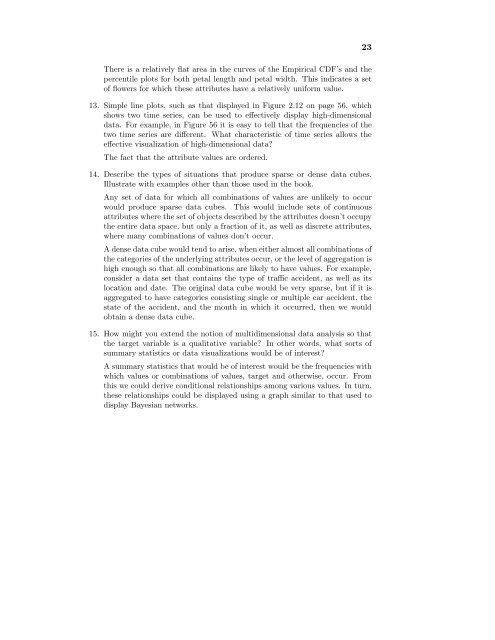Introduction To Data Mining Instructor's Solution Manual
Introduction To Data Mining Instructor's Solution Manual
Introduction To Data Mining Instructor's Solution Manual
Create successful ePaper yourself
Turn your PDF publications into a flip-book with our unique Google optimized e-Paper software.
There is a relatively flat area in the curves of the Empirical CDF’s and the<br />
percentile plots for both petal length and petal width. This indicates a set<br />
of flowers for which these attributes have a relatively uniform value.<br />
13. Simple line plots, such as that displayed in Figure 2.12 on page 56, which<br />
shows two time series, can be used to effectively display high-dimensional<br />
data. For example, in Figure 56 it is easy to tell that the frequencies of the<br />
two time series are different. What characteristic of time series allows the<br />
effective visualization of high-dimensional data?<br />
The fact that the attribute values are ordered.<br />
14. Describe the types of situations that produce sparse or dense data cubes.<br />
Illustrate with examples other than those used in the book.<br />
Any set of data for which all combinations of values are unlikely to occur<br />
would produce sparse data cubes. This would include sets of continuous<br />
attributes where the set of objects described by the attributes doesn’t occupy<br />
the entire data space, but only a fraction of it, as well as discrete attributes,<br />
where many combinations of values don’t occur.<br />
A dense data cube would tend to arise, when either almost all combinations of<br />
the categories of the underlying attributes occur, or the level of aggregation is<br />
high enough so that all combinations are likely to have values. For example,<br />
consider a data set that contains the type of traffic accident, as well as its<br />
location and date. The original data cube would be very sparse, but if it is<br />
aggregated to have categories consisting single or multiple car accident, the<br />
state of the accident, and the month in which it occurred, then we would<br />
obtain a dense data cube.<br />
15. How might you extend the notion of multidimensional data analysis so that<br />
the target variable is a qualitative variable? In other words, what sorts of<br />
summary statistics or data visualizations would be of interest?<br />
A summary statistics that would be of interest would be the frequencies with<br />
which values or combinations of values, target and otherwise, occur. From<br />
this we could derive conditional relationships among various values. In turn,<br />
these relationships could be displayed using a graph similar to that used to<br />
display Bayesian networks.<br />
23


